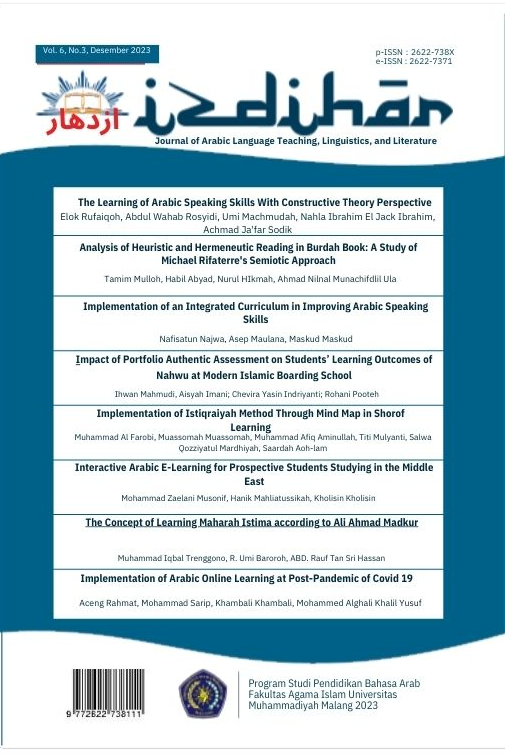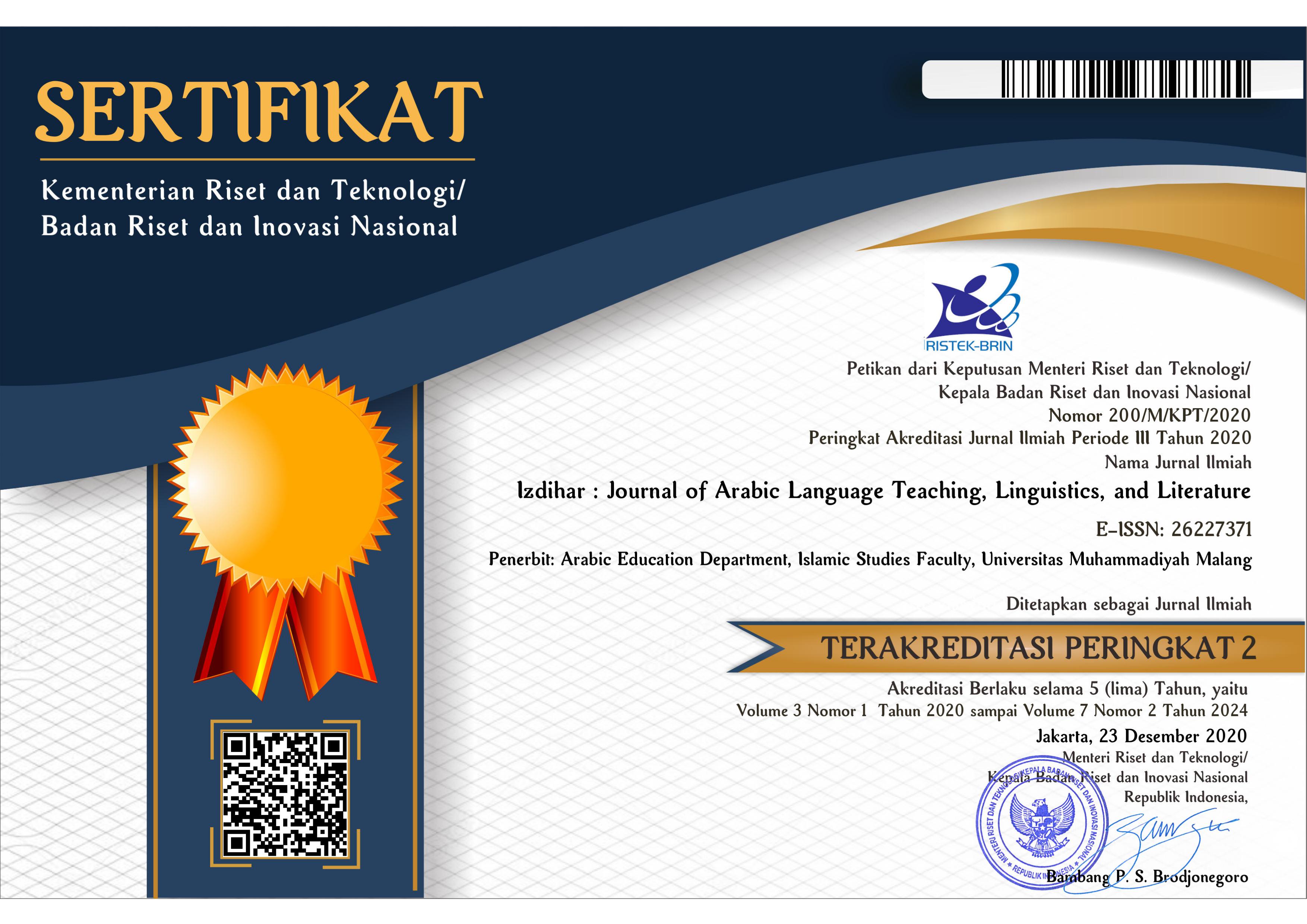Analysis of Heuristic and Hermeneutic Reading in Burdah Book: A Study of Michael Rifaterre's Semiotic Approach
DOI:
https://doi.org/10.22219/jiz.v6i3.28190Keywords:
concept of love; heuristics; hermeneutics; semiotics; sya'ir.Abstract
This study aimed to analyze the application of Michael Rifaterre's semiotic approach in discussing heuristic and hermeneutic reading methods in the book of Burdah. This research used a qualitative approach with a focus on text analysis. The method used involves Michael Rifaterre's semiotic approach as the main framework. Data was collected through literature studies related to Burdah and semiotic approaches, as well as analysis of Burdah texts using heuristic and hermeneutic lenses. The results showed that the heuristic approach helps reveal symbolic and metaphorical elements, while the hermeneutic approach deepens the understanding of the historical and cultural context surrounding Burdah. Thus, a combinative reading of both approaches forms a more holistic understanding. The study concluded that Michael Rifaterre's semiotic approach can be an effective framework for analyzing heuristic and hermeneutic readings in classical Islamic texts such as Burdah. The combination of the two approaches enriches the understanding of literary work, revealing deeper layers of meaning.
Downloads
References
Al-Azhar, K. (2018). Syarah Burdah. Silsilah Turost Al-Azhariyyin.
Al Ghulayaini, M. (2007). Jāmi’ud-Durūs al-Arabiyyah. Dār al-Chadīts.
Alaydrus, H. M. B. A. (2019). Khowasshu Burdatil Madih. Kalam Salaf.
Ambarini, & Umaya, N. M. (2016). Smiotika: Teori dan Aplikasi pada Karya Sastra. IKIP PGRI Semarang Press.
Asqi, N., & Febriani, V. (2021). Kondisi Perempuan dalam bait puisi“ Kitab Al-hubb” Karya Nizar Qabbani (Analisis Semiotika Riffaterre). Al-Fathin, 4(1). https://doi.org/https://doi.org/10.32332/al-fathin.v4i01.3028
Demokrawati, H. A., & Widowati. (2015). Tinjaun Semiotika Riffaterre Pada Cerpen “Bulan Kuning Sudah Tenggelam” Karya Ahmad Tohari. Caraka: Jurnal Ilmu Kebahasaan, 1(2). https://doi.org/10.30738/caraka.v1i2.1916
Dwipayanti, N. K., Mandala, A. K. U. D. A., & Dwi, P. T. K. (2021). Analisis Semiotika Riffaterre dalam Lagu Sakura Karya Naotaro Moriyama. Jurnal Pendidikan Bahasa Jepang Undiksha, 7(2). https://doi.org/https://doi.org/10.23887/jpbj.v7i2.34461
Fajri, M. (2020). Interpretasi Surah Al-Maidah Ayat 38: Analisis Semiotika Mizhael Riffaterre. Al-Itqan: Jurnal Studi Al-Qur’an, 6(2). https://doi.org/doi.org/10.47454/itqan.v6i2.67
Fajrin, S. F. (2019). Semiotika Michael Camille Riffaterre: Studi Analisis Al-Quran dalam Surat Al-Baqarah Ayat 223. Al-Furqon, 2(2). https://ejournal.iai-tabah.ac.id/index.php/Alfurqon/article/view/463
Hegele, A. (2021). Hermeneutic Dissection in the Lyric. In Romantic Autopsy: Literary Form and Medical Reading. Oxford University Press. https://doi.org/10.1093/oso/9780192848345.003.0002
Kurniawan, Sholihin, & Mulyadi. (2019). Figurative of Lo I Keta Spells in Society of Bima: A Riffaterre Semiotics Research. Aksis, 3(1). https://doi.org/https://doi.org/10.21009/AKSIS.030109
Marahayu, N. M., Suhardi, I., & Yanti, S. N. H. (2019). Makna Lirik Lagu Sekar Gadung dalam Pementasan Lengger Lanang Langgeng Sari: Perspektif Semiotika Riffaterre. Jurnal Sastra Indonesia, 8(3). https://journal.unnes.ac.id/sju/index.php/jsi/article/view/36029
Margolis, J., & Riffaterre, M. (1980). Semiotics of Poetry. The Journal of Aesthetics and Art Criticism. https://doi.org/10.2307/429927
Mert, C., & Milnikov, A. (2010). Heuristic Analysis of Time Series Internal Structure. https://api.semanticscholar.org/CorpusID:118270656
Noer, K. A. (2012). Hermeneutik Sufi : Sebuah Kajian atas Pandangan Ibn Arabi tentang Takwil al-Qur’an. Kanz Philosophia A Journal for Islamic Philosophy and Mysticism, 2(2). https://doi.org/10.20871/kpjipm.v2i2.35
Palmer, R. E. (2005). Hermeneutika Teori Baru Mengenai Interpretasi. Pustaka Pelajar.
Pradopo, R. D. (1999). Semiotika: Teori, Metode, Dan Penerapannya Dalam Pemaknaan Sastra. Jurnal Humaniora. https://doi.org/10.22146/jh.628
Puspita, S. M., Nurbayan, Y., & Sauri, S. (2020). Asy-Syi’ru ‘Du’a’ li Khalil Jibran wa Mikhail Na’imah wa Nasib ‘Aridah wa Abdul Masih Haddad (at-Tahlil as-Simiyai li Michael Riffaterre). International Journal of Arabic Language Teachin, 2(1). https://doi.org/https://doi.org/10.32332/ijalt.v2i01.2079
Rabianti, N. (2019). Cenningrara ‘Mantra Pekasih’ Di Kabupaten Soppeng (Kajian Semiotik Rifaterre). Pusaka Jurnal, 7(1). https://doi.org/https://doi.org/10.31969/pusaka.v7i1.243
Riffaterre, M. (1978). Semiotics Of Poetry. Indiana University Press.
Rochim, N. N. (2020). Puisi Al-Kulira Karya Nazikh Al-Mala’ikah (Studi Analisis Semiotika Michael Riffaterre). Ajamiy, 9(2). https://doi.org/http://dx.doi.org/10.31314/ajamiy.9.2.225-238.2020
Santoso, B., & Lewa, A. H. (2020). Makna Pesan Sosial dalam Iklan Layanan Masyarakat “Stereotip Z”: Sebuah Kajian Semiotika Riffaterre. Nusa: Jurnal Ilmu Bahasa Dan Sastra, 15(4). https://doi.org/https://doi.org/10.14710/nusa.15.4.477-491
Warson, A. M. (1984). Kamus Al-Munawwir Arab Indonesia Terlengkap. Pustaka Progresif.
Downloads
Published
How to Cite
Issue
Section
License
Copyright (c) 2023 Tamim Mulloh, Habil Abyad, Nurul Nurul HIkmah

This work is licensed under a Creative Commons Attribution-ShareAlike 4.0 International License.
Copyright Notice
Authors who publish with this journal agree to the following terms:
- Authors retain copyright and grant the journal right of first publication with the work simultaneously licensed under a Creative Commons Attribution-ShareAlike 4.0 International License that allows others to share the work with an acknowledgment of the work's authorship and initial publication in this journal.
- Authors are able to enter into separate, additional contractual arrangements for the non-exclusive distribution of the journal's published version of the work (e.g., post it to an institutional repository or publish it in a book), with an acknowledgment of its initial publication in this journal.
- Authors are permitted and encouraged to post their work online (e.g., in institutional repositories or on their website) prior to and during the submission process, as it can lead to productive exchanges, as well as earlier and greater citation of published work (See The Effect of Open Access).
Copyright (c) 2019 Izdihar : Journal of Arabic Language Teaching, Linguistics, and Literature

This work is licensed under a Creative Commons Attribution-ShareAlike 4.0 International License.


















